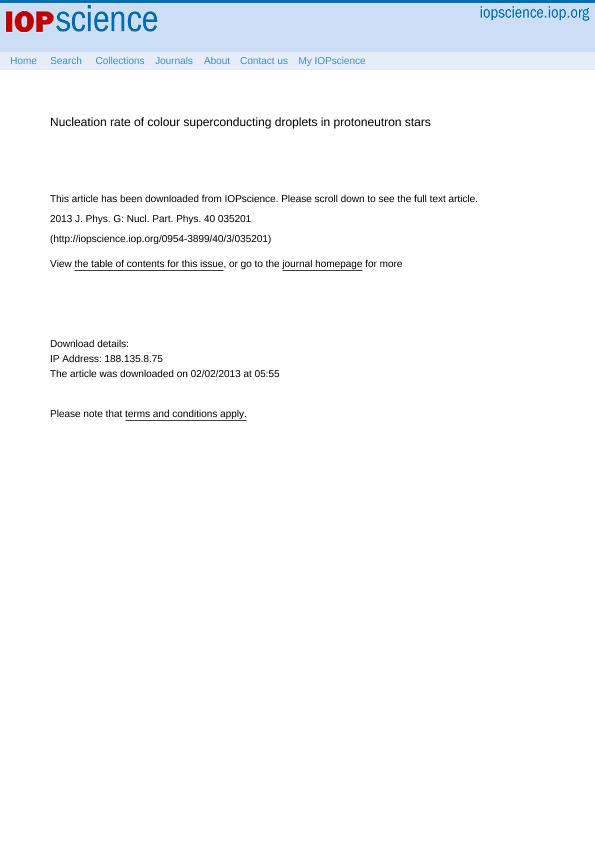Mostrar el registro sencillo del ítem
dc.contributor.author
Do Carmo, T.A.S.
dc.contributor.author
Lugones, G.
dc.contributor.author
Grunfeld, Ana Gabriela

dc.date.available
2019-05-22T15:20:29Z
dc.date.issued
2013-03
dc.identifier.citation
Do Carmo, T.A.S.; Lugones, G.; Grunfeld, Ana Gabriela; Nucleation rate of colour superconducting droplets in protoneutron stars; IOP Publishing; Journal Of Physics G-nuclear And Particle Physics; 40; 3; 3-2013; 35201-35214
dc.identifier.issn
0954-3899
dc.identifier.uri
http://hdl.handle.net/11336/76847
dc.description.abstract
We analyse the nucleation of quark matter droplets under protoneutron star conditions. We adopt a two-phase framework in which the hadronic phase is described through a nonlinear Walecka model and the just deconfined matter by the MIT bag model including colour superconductivity. Surface tension and curvature energy are calculated self-consistently within the multiple reflection expansion formalism. We impose flavour conservation during the transition, which means that the just deconfined quark droplet is transiently out of equilibrium with respect to weak interactions. Our results show that trapped neutrinos slightly increase the critical density for deconfinement and that colour superconductivity significantly decreases such density at low temperatures. We also show that the nucleation rate is negligible for droplets larger than 100-200 fm and is huge for smaller droplets provided that the temperature is low enough. We compare our results with previous calculations using the Nambu-Jona-Lasinio model with colour superconductivity and the MIT bag model without colour superconductivity. We conclude that the deconfinement transition should be triggered instantaneously when a density slightly larger than the bulk transition density is reached at some layer of a protoneutron star. Since colour superconductivity lowers the transition density at low temperatures, the transition is likely to occur after significant cooling in a massive enough protoneutron star. © 2013 IOP Publishing Ltd.
dc.format
application/pdf
dc.language.iso
eng
dc.publisher
IOP Publishing

dc.rights
info:eu-repo/semantics/openAccess
dc.rights.uri
https://creativecommons.org/licenses/by-nc-sa/2.5/ar/
dc.subject
Estrellas de Neutrones
dc.subject
Modelos Efectivos
dc.subject.classification
Astronomía

dc.subject.classification
Ciencias Físicas

dc.subject.classification
CIENCIAS NATURALES Y EXACTAS

dc.title
Nucleation rate of colour superconducting droplets in protoneutron stars
dc.type
info:eu-repo/semantics/article
dc.type
info:ar-repo/semantics/artículo
dc.type
info:eu-repo/semantics/publishedVersion
dc.date.updated
2019-05-21T20:50:48Z
dc.journal.volume
40
dc.journal.number
3
dc.journal.pagination
35201-35214
dc.journal.pais
Reino Unido

dc.journal.ciudad
Londres
dc.description.fil
Fil: Do Carmo, T.A.S.. Universidade Federal Do Abc; Brasil
dc.description.fil
Fil: Lugones, G.. Universidade Federal Do Abc; Brasil
dc.description.fil
Fil: Grunfeld, Ana Gabriela. Consejo Nacional de Investigaciones Científicas y Técnicas; Argentina. Comisión Nacional de Energía Atómica. Centro Atómico Constituyentes; Argentina
dc.journal.title
Journal Of Physics G-nuclear And Particle Physics

dc.relation.alternativeid
info:eu-repo/semantics/altIdentifier/url/https://iopscience.iop.org/article/10.1088/0954-3899/40/3/035201/meta
dc.relation.alternativeid
info:eu-repo/semantics/altIdentifier/doi/http://dx.doi.org/10.1088/0954-3899/40/3/035201
Archivos asociados
